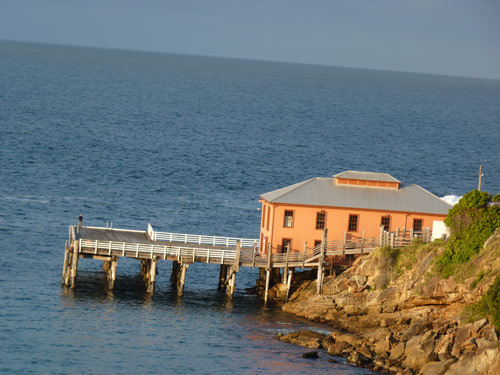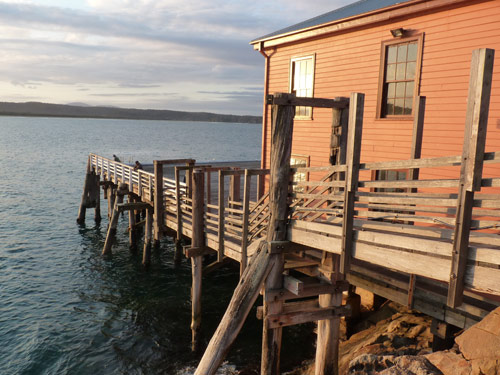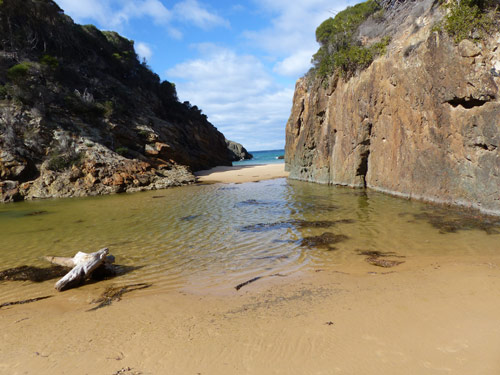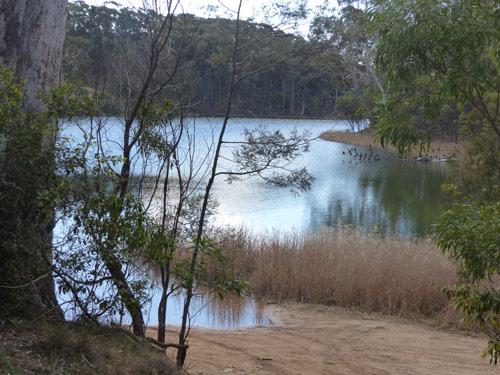TATHRA WHARF
Tathra wharf is situated on the far south coast of New South Wales. Tathra is a picturesque, beachside village not far east of Bega. Some years ago, my family chose to make it our annual holiday destination. My wife and I found it a wonderful place to spend quality time with our granddaughters who live inter-state. In 2019, having not been to Tathra for a few years, we decided to return on our own. The area, despite suffering a savage bushfire since our last visit, had lost none of its charm.

Historic Tathra Wharf
In the first hours of arrival, I had always found myself drawn to the historic Tathra wharf. This time was no different. As soon as you start walking across the beach, you see the old wharf. Perched at the foot of the southern headland, it almost seems at times to float on the shimmering, motionless waters.
A timber structure, the wharf was opened in 1862. Construction costs were covered by a colonial government grant. Over the following years it was enlarged to accommodate the growing cargo and passenger trade and the increasing size of the steamships. By the beginning of World War 1, the wharf comprised a two-storey cargo shed, a derrick crane, a cattle race, as well as loading ramps and chutes. The wharf also included a buffering system to protect the wharf and visiting vessels from damage.

Tathra’s southern headland, however, provided little protection from the ocean’s temperament. In times of bad weather, steamers found it too dangerous to approach the wharf. If local boats could not safely reach the steamers to deliver and retrieve cargo or passengers, then the steamers had to bypass Tathra altogether. This could be a frequent inconvenience, for vessels stopped at Tathra twice a week, each way, on their passage back and forth from Sydney and Eden. The 28 April 1883 edition of Australian Town and Country Journal, claimed that ‘it is the most unlikely place for a port that could be imagined.’
To overcome the Tathra wharf’s limited protection from inclement weather, Wallagoot Lake was at one time considered a viable alternative site. A little further south, this lake was expansive and deep. A gap in the northern, rocky cliffs was suggested as a suitable entrance from the Pacific Ocean. The same Australian Town and Country article suggested that ‘without much engineering skill or, serious cost’ the gap could be widened, making ‘a navigable channel between the sea and lake’. The plan was never acted upon.

Wallagoot Gap
During my visit this year, I made a point of wading through this rock opening, called Wallagoot Gap, to consider its suitability. I could not help feeling that this proposed enterprise could have been fraught with danger, especially in windy conditions or rough seas.
Albert McKnight wrote an article in the Bega District News, 30 May 2018, basing it around information provided by Ngarigo and Djiringanj elders, Ellen Mundy and David Dixon. They told of their ancestors who used to catch and break in the wild horses around Mt Crackenback in the Snowy Mountains. The horses were taken all the way to Tathra where they were shipped to Sydney. Some of these horses were later used in the Boer War.
According to Ellen Mundy, the Aboriginal horsemen would follow the traditional, safer pathways to the coast. These routes descended more gently and also afforded the horses good food and water stops.

Blackfellows Lake
Before arriving at the Tathra wharf, the horses were rested for a week or so at Blackfellows’ Lake at Kalaru. This lake was a backwater of the Bega River and had been a traditional hunting ground for the local coastal Aboriginal people. Burial sites have also been found there. Gilbert Mant, writing in the Daily Telegraph, 8 May1926, claimed that ‘on a sunny summer’s day it is one of the most naturally beautiful places in Australia. Its naturalness is its charm’. He continued, ‘It basks peacefully in the sunshine with only the songs of the birds and the whisper of the trees to disturb the silence.’ Since the lake is not far from Tathra, I made a point of visiting there this year. Although my visit was in late winter, the seclusion and serenity of the lake certainly lived up to Mant’s description. There is no clear signage to this special place and the connection of the Snowy Mountains’ indigenous stockmen with the area goes unheralded.
Tathra wharf’s busiest working years were between 1880 and 1920. However, with the improvement in roads, sea trade began to decline. The last cargo to leave the wharf was in November 1954.
In the late 1970s, after years of disrepair and weathering, restoration work began on this once vitally important building, often referred to as ‘the port of Bega’.
© Jim Low
